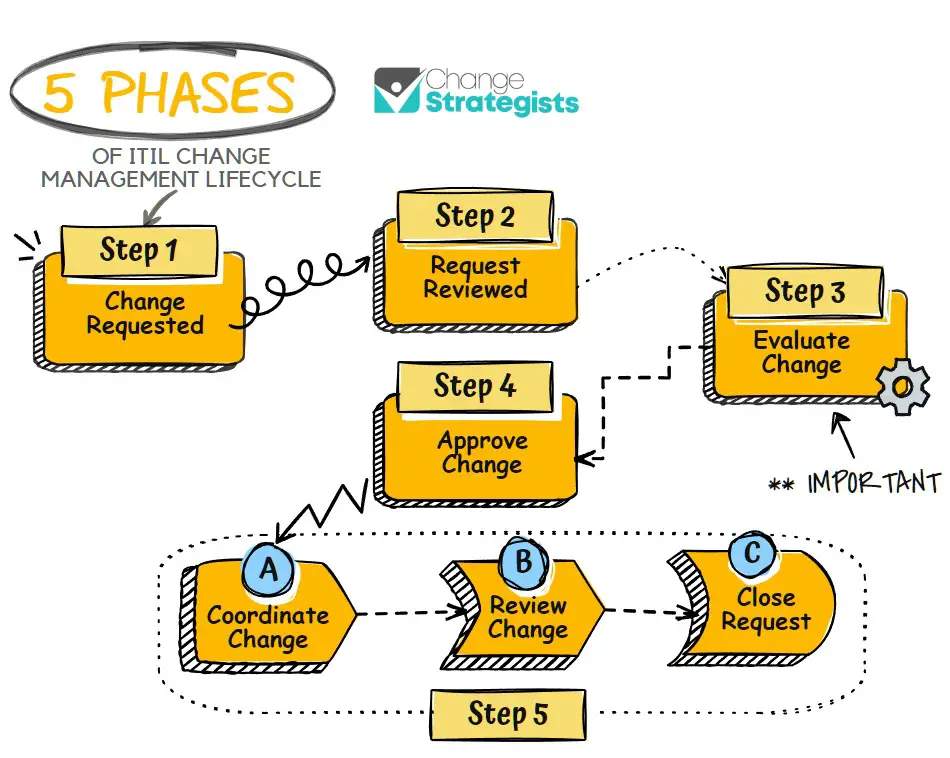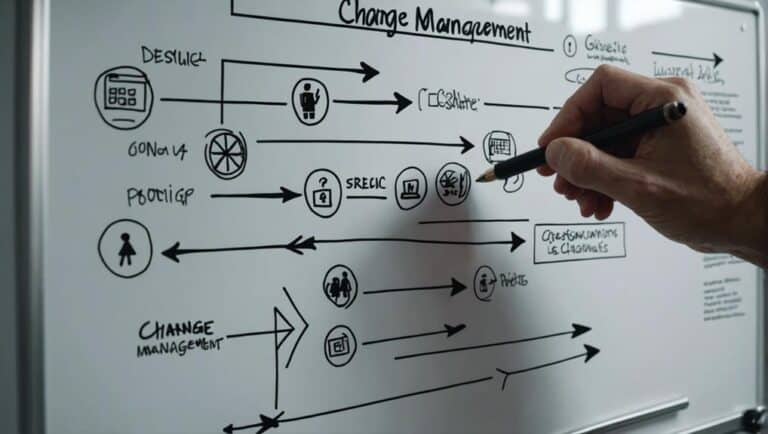Change is tricky and significantly trickier in an IT environment where multiple things can go wrong, and mistakes can result in huge setbacks. The IT Infrastructure Library (ITIL) lays out the best practices for change that we will further explore in this article to help you navigate a change for your IT company or project.
ITIL change management best practices include effective communication, staying flexible, engaging early and often, and setting KPI metrics. ITIL specifically deals with transition processes in the IT environment.
ITIL clearly states that an organization’s success depends on continuous improvement driven by changes. Can you imagine being blindfolded and told to drive without even knowing where you are going and, of course, being blind? That is what it’s like trying to implement a change in an IT organization without the ITIL best practices for change management.
What is ITIL?
ITIL, or the Information Technology Infrastructure Library, is a set of best practices for managing IT service delivery. It is used by businesses and organizations to help them plan, deliver, and support IT services.
The main focus of ITIL is on aligning IT services with business needs and providing value to customers. Its goal is to help businesses improve their performance and avoid disruption while delivering quality services.
To do this, it provides guidance on how to design, implement, operate, monitor, optimize, and continually improve services, categorising the process into 5 phases.

7 Best ITIL Change Management Practices
ITIL V4 focuses more on the idea of change enablement rather than management as defined in ITIL V3.
Let’s look at some of the best practices within the ITIL that ensure success during a transition.
Identify the need for change
The first step is to identify the “why’. This will help you set the objectives for the process. These objectives will guide your process and your KPIs. Clear goals will also help you convince your stakeholders and get their buy-in which is crucial for the process’s execution.
Do an impact analysis
How will the proposed change impact the organization? Your systems and employees, and most importantly, your customers and vendors? These are the questions you need to ask yourself during the planning change, and these are the questions your stakeholders will ask you.
Risks and possible reasons for resistance need to be quantified beforehand to eliminate human blockers and to have a robust resistance management plan in place.
You also need to work on a roll-back strategy in case the change implementation fails. This strategy should focus on restoring the organization to the pre-change processes and systems while a further action plan is developed to implement change again.
Communicate consistently and constantly
Communication is undoubtedly the most critical aspect of change. It is what drives the need for change and sees it through the last milestone. If you want your employees and stakeholders to commit to change, you must show them what’s in it for them.
This visualization is only possible through effective communication at every process stage. A clear communication plan must be developed during the planning changes that include all available communication channels and mediums to get the message across to every employee.
Define change and its type
Change comes in different forms. To ensure everyone in the organization is on the same page, you need to define the types of changes and stick to them. Here are some standard definitions you can use:
Standard Changes
These are the most common changes applied in an organization and can be executed using an IT organization’s existing processes and infrastructure. These are routine changes, and their results and risks are known upfront. They rarely require any approvals from the management or stakeholders, so they are the easiest to implement.
Normal Changes
These changes have to go through the approval process. If, during the risk assessment phase, it is determined that the change poses a high risk, a change advisory board must deliberate on its need before giving approval.
Emergency Changes
As the name suggests, these changes are the need of the hour based on emergency cases. A process may go wrong, or a technology implementation may fail.
Approvals may be required in haste in order to minimize the damage done, and change managers have to be flexible regarding their processes in the face of such changes. Ignoring them often poses a threat to the health of the organization.
Clearly define the roles and responsibilities
Before you can begin utilizing the ITIL best practices for transition, you must assign your team members the proper roles and responsibilities. The most common roles as defined by the ITIL are:
Change initiator
The change initiator is the one who recognizes and promotes the ‘why”. Ideally, these are members of the support team that interacts with the system frequently and deals with customers as a result of problems. They are first-hand system users and have the most knowledge regarding blockers and issues. They essentially identify the need for change.
Change coordinator
A change coordinator deals with all the incoming change requests as a result of program management, release management, and incident management. They receive requests for change from different teams and departments, assess the risks and needs involved with it, and then develop a complete implementation plan.
They typically coordinate with all the organizational change initiators and the technical teams who implement these changes.
Change manager
This role is typically required in medium and larger-sized IT organizations. There will be a need for one or more people in this role responsible for managing the processes, prioritizing requests and the risks associated with them, and overseeing the implementation of the changes. They will also maintain detailed documentation for each incoming change request.
Change Advisory Board
When a change manager does an impact analysis and discovers that a change poses a high risk to the existing processes and infrastructure, the change advisory board evaluates it. They authorize or reject the change based on their deliberation. This is normally done by holding a meeting and determining the effects of the high-risk change on all the affectees.
Approver
The approver decides whether a change gets approved or is rejected.
Change implementation team
These are specialists and technical experts who implement the planned changes. Managers are often assigned to oversee the changes in this team, while their direct reports are the ones who are assigned milestones to achieve.

Engage With the Users
Insight is crucial in an IT organization. You get valuable knowledge when you engage with employees and users regarding the process being changed or the software being implemented.
Since these people are directly involved in using these processes and software, they can offer first-hand feedback that can help you set the right objectives for the process in the planning stage.
Develop Workflows
Workflows help give your process a structure. A standard change management workflow, according to the ITIL, looks like the following:
Planning
This stage involves planning the entire implementation phase of the change. Change managers and coordinators are actively involved in this stage, and they lay out the objectives, KPIs, and milestones of the change. Resistance management and communication plans are also developed during this stage.
Approval
Once the changes have been planned and presented to the approvers, they work with the coordinators and managers to approve or reject the proposed changes based on risk and impact analysis.
Implementation
This stage involves the implementation of the change by the technical teams. Constant communication is a part of this stage.
Closure
Technical teams and specialists use this process when they test out production changes after the implementation stage, and coordinators utilize this process when they close out a change request.
This is just a brief explanation of the process, which we will cover in detail in the section below.
The ITIL Change Management Process
Any successful process depends on the execution of the steps. If you know which step follows the one you are at, you don’t have to stop and second guess yourself before moving forward. This section will cover the steps involved in a standard ITIL change management process:
Step 1 – Creating a Change Request
A change initiator submits a request for a change. At this stage, they are responsible for documenting why change is needed and its possible impact on the organization. You will also need to detail all the implementation steps and the risks involved in implementing this change.
The following information may be required to establish the need for change:
- Incidents that led to the need for the change
- Details of implementation steps
- Impact on all associated teams and systems
- Roles and responsibilities of everyone involved in the implementation
- A rollback plan in case the implementation is unsuccessful
- A list of approvers
Step 2 – Reviewing a Change Request
During this stage, the approver will assess the practicality of the change. They will review whether the request is valid and if it addresses a problem that really needs a solution. Based on their analysis, they will determine whether the request merits the dedication of time and resources or not.
The following things are taken into consideration when making this decision:
- The role of the requestor
- The impact of the change on the organization
- Estimated return on investment
- Resources required to implement a request
The approver will also determine who will implement the change and whether they have the capacity to do so at the moment.
Step 3 – Planning a Change
Once you’ve made the request, it is time for you to plan the implementation of change as if it was approved. This step involves documenting all the steps involved in the process and the possible outcomes of each step.
It will also include the resources required and a tentative timeline. This is the content that will enable you to convince the stakeholders.
Step 4 – Testing a Change
This stage is especially important when software or systems are involved. You will need to test the change before you submit it for approval. You can do small-scale testing to see whether it is successful or not and also determine the steps involved. This stage also gives you the unique opportunity to work out any problems in the process.
Step 5 – Creating a Proposal
Once the above steps have been executed, it is time to document everything in a proper proposal. Your proposal will include the type of change, its priority, the steps involved, and the outcomes of a request.
This proposal will be submitted to the person who will authorize the implementation. Your documentation needs to make a case for why a change is required and its impact on the organization.
Step 6 – Implementing a Change
Implementation isn’t the only step in the process; it is a complete journey. The planning stage has to finish with the complete build of the change, and then after implementation, the change has to be tested to ensure success.
Similarly, if the implementation fails, a fallback strategy has to be implemented to minimize the effects of failure and restore things back to the initial stage.
Step 7 – Reviewing Change Progress
You’ve implemented the change as planned; now what? Reviewing a process after it is implemented is crucial for continuous improvement. You need to check the results and understand whether the KPIs you set were achieved or not. What could you have done better, and what can still be improved?
Answering these questions will allow you to improve your future change management process.
Step 8 – Closing a Change
Once the implementation is done, you need to document each step and its outcome through proper documentation. This documentation must be added to a central database where everything must be accessible to all the employees and stakeholders.
After this documentation is done, the process is complete and can be closed out.
Frequently Asked Questions
What is ITIL?
Information Technology Infrastructure Library (ITIL) is a standard framework designed to help IT organizations manage processes. It deals with the selection, planning, delivery, and lifecycle of IT projects with the goal of increasing productivity and efficiency.
Why is ITIL useful for a business?
ITIL is designed to improve the efficiency of an IT business through standardized and tested processes and procedures. It offers the best solution for IT service management businesses and helps them reduce costs and improve ROI.
Implementing these best practices can provide your company with numerous benefits, including improved efficiency and effectiveness of changes, reduced downtime and disruptions, better control over the environment, and improved communication between all parties involved in the change process. Ultimately, following ITIL Change Management best practices can help to ensure that changes are implemented smoothly and successfully within your organization.
Under ITIL, do changes in business processes fall under the scope of Change Management?
Yes, changes in business processes fall under the scope of Change Management under ITIL. Change Management is responsible for ensuring that changes to the IT infrastructure are made in a controlled and coordinated manner, and that the impact of those changes on business objectives is minimized.
What is the objective of ITIL change management?
The objective of ITIL change management is to ensure that changes are made with minimum disruption to services.
What Are Some Best Practices for Change Management According to ITIL?
When it comes to change management, following the 9 things during change management according to ITIL can lead to success. These include ensuring clear communication, establishing a detailed plan, assessing risks and impacts, obtaining stakeholder buy-in, and conducting thorough testing. Adhering to these best practices can help minimize disruptions and ensure smooth transitions.
Final Thoughts
The ITIL change management best practices are laid out to make changes in the IT sector much smoother and easily trackable. There are a few key things to keep in mind when implementing change management best practices from ITIL.
First, always involve the right people in the process and make sure everyone is on board with the changes.
Secondly, communication is critical throughout the entire process – keep everyone updated on what’s happening and why certain decisions are being made.
Finally, document everything thoroughly so that there is a clear record of all changes made.
By following these simple guidelines, you can ensure a smooth transition to using ITIL best practices for change management within your organization.
We hope that our curation of best practices allows you to map out your process for a successful implementation.





